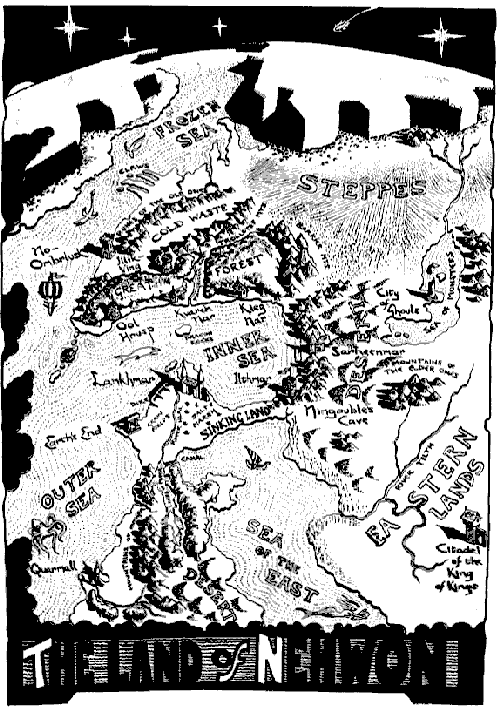NEHWON CHARACTERS
Sundered from us by gulfs of time and stranger dimensions dreams the ancient world of Nehwon with its towers and skulls and jewels, its swords and sorceries. Nehwon's known realms crowd about the Inner Sea: northward the green-forested fierce Land of the Eight Cities, eastward the steppe-dwelling Mingol horsemen and the desert where caravans creep from the rich Eastern Lands and the River Tilth. But southward, linked to the desert only by the Sinking Land and further warded by the Great Dike and the Mountains of Hunger, are the rich grain fields and walled cities of Lankhmar, eldest and chiefest of Nehwon's lands. Dominating the Land of Lankhmar and crouching at the silty mouth of the River Hlal in a secure corner between the grain fields, the Great Salt Marsh, and the Inner Sea is the massive-walled and mazy-alleyed metropolis of Lankhmar, thick with thieves and shaven priests, lean-framed magicians and fat-bellied merchants—Lankhmar the Imperishable, the City of the Black Toga."
THE WORLD OF NEHWON

Fafhrd, the Grey Mouser, and the world of Nehwon (“no when”) were created by Fritz Leiber, who much like Michael Moorcock and Elric, wanted to create a more “human” sword-and-sorcery hero, as opposed to Conan or Tarzan and their far more superhuman physiques and exploits. His first story was The Jewels in the Forest published in 1939 (known then as Two Sought Adventure), followed by The Bleak Shore in 1940. He then wrote additional stories over the next 40 years, eventually producing seven volumes detailing the life and adventures of this most notorious pair of rogues. In 1970, he wrote Ill Met In Lankhmar, in which Fafhrd and the Mouser meet for the first time (this coming after 30 years of stories featuring them together). It won the Nebula and Hugo awards, the only Fafhrd and Grey Mouser stories to do so.
Unlike the world of Conan’s Hyboria, which contains many easily identifiable pastiches of real-world cultures, Nehwon is far more surreal and strange. The most obvious nod to our Earth is the Mingols, who are modeled on the Mongols. In addition, the northmen of the Cold Waste are meant to be Norsemen, but other than that, the various people and places Fafhrd and the Grey Mouser meet have no real Earth analogs. There is also more magic in Nehwon, making it reminiscent of Elric of Melnibone’s world. Mouser has some sorcerous skill, while the women of Fafhrd’s clan practice strange ice magics. In addition, the two of them come across, and use, enchanted items from time to time, including a potion that allows one to shrink to rat size and a whistle that can summon great fighting cats.
The denizens of Nehwon are equally bizarre. There are behemoths, seagoing leviathans, ice gnomes, hyper-intelligent rats, furred hot-blooded snow snakes, and more. In addition, there are the clear-fleshed ghouls, who appear as skeletons, the invisible people of Stardock Mountain, and a whole race of people who dwell amid the clouds. Finally, there are the gods, who live in the south of Lankhmar, in the well-named Godsland. Numerous, and often bored, they take great interest in the activities of man, especially of those men are their worshippers (even if only nominally). And like any bored beings of great power, they can be remarkably petty.
After reading my entire collection of Fafhrd and Grey Mouser stories, I’ve decided to try to create character sheets for some of the more notable persons and creatures. When I’m done, I hope to have character sheets for Fafhrd, Grey Mouser, the Nehwon Ghoul Kreeshka, the Cloud of Hate, a Furred Snow Serpent, an Ice-Cat, the Warrior’s Doom, and a generic Nehwon Ghoul.
Bibliography
- Swords And Deviltry
- Swords Against Death
- Swords In The Mist
- Swords Against Wizardry
- The Swords Of Lankhmar
- Swords And Ice Magic
- The Knight And Knave Of Swords
For these character sheets, I used the Orion/Millennium Fantasy Masterworks editions, consisting of The First Book of Lankhmar (containing books 1-4) and The Second Book of Lankhmar (containing books 5-7).
Return to Book-Derived HERO System Character Adaptations.